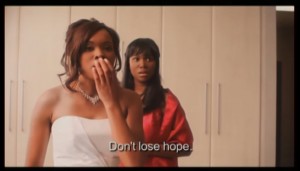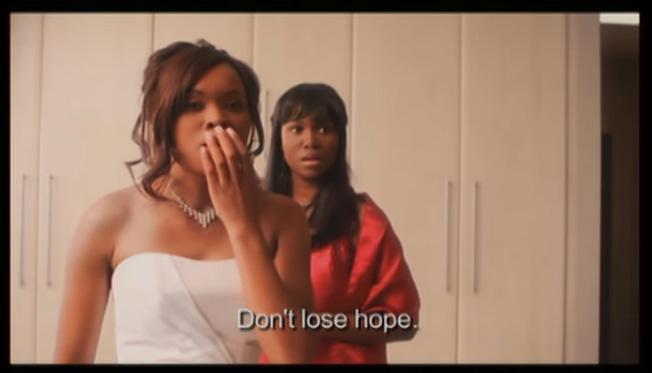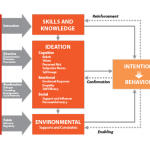Innovation Webinar 6 Recap: Social Drama and Health Communication

A scene from the first season of Intersexions, a South African social drama about HIV and the role of sexual networks in its transmission.
HC3’s sixth Innovation Webinar provided participants with foundational insights into techniques and theories for the creatively inspired field of social drama as well as their application to health communication.
Moderator John Somers, Honorary Fellow in the Department of Drama at Exeter University, opened the discussion with an explanation of social drama as “drama and theater with a job to do.” Also known as entertainment-education (EE), social drama aims to address a particular issue in need of societal or personal change. The drama is planned by skilled media or theatre practitioners and in collaboration with community members and others whose roles have relevance to the issue at hand.
“Whatever the medium, the drama story is developed to have the best chance of bringing about the desired change,” Somers said. “Many research and evaluations prove that if well planned and executed, drama is a very effective agent for education and change.”
Understanding the elements
Dr. Kriss Barker, Vice President of International Programs at Population Media Center, presented a unique form of EE pioneered by Mexican producer, Miguel Sabido.
Sabido’s method hones in on three key elements important for developing programs with both educational and entertainment value:
1) They must be long-running, allowing time for the audience to form bonds with the characters and for the characters to evolve
2) They should be melodramatic, addressing emotionally charged issues in an entertaining way and letting emotions influence behavior more than purely cognitive information
3) They should depict real people and real lives
Dr. Barker emphasized the importance of strong dramatic script writing while having a good multi-media mix. The drama should not stand alone, but be the center of a larger, comprehensive communication campaign.
“This is not a cookie-cutter approach – you have to design the programs for specific audiences, using culturally specific information and local language.”
Changing the world by re-scripting our stories
Dr. Arvind Singhal, Director of the Social Justice Initiative at the University of Texas, presented an examination of the impact of re-scripting stories.
He called on a quote from GK Chesterson: “Fairy tales are more than true.”
“Fairy tales are true,” Dr. Singhal said, “not just because they tell us that monsters exist, but also because they tell us that monsters can be vanquished. Stories can take us to places that we’ve never been and have a role in re-scripting our current social norms and human behavior.”
Dr. Singhal shared an example from Soul City in South Africa, which produces one of the country’s most popular television series. The show is distinctive from others in its focus on research to inform theme development.
Research revealed three typical deeply entrenched and intertwined preexisting storylines related to domestic violence –one for the man, one for his partner and one for their neighbors.
The man is portrayed as “the captain of the ship” and could do anything when at home to “put the woman in her place.” The woman plays the role of a helpless victim who could do very little within the private space of her own home. Even if she gathered enough courage to ask for help from her own mother, she’d be told to endure. She performed this script day in and day out, powerless and silent as the cycle of violence escalated. The neighbors meanwhile knew what was going on but viewed it as a private matter and not their place to intervene.
Because of what the research revealed, the Soul City writers spun a new story to disrupt and overthrow the existing behaviors. On the show, the neighbors’ who were once-silent bystanders came outside when they heard signs of abuse to stand by the aggressor’s home and bang on their pots and pans in protest.
An evaluation of the series indicated many people were influenced and empowered to take action as a result. After the new storyline was introduced on primetime television, many communities began to take action through similar behaviors, like banging on beer bottles when witnessing unruly interaction between partners at a bar. Mirrored behaviors reported like these prove ingrained scripts can in fact be “unstuck” by the “power of the pen.”
“Stories can be re-scripted. The world can be changed,” Dr. Singhal said. “What we need is the dance of researchers, the producers and the change agents.
Developing a multi-platform drama to fight HIV
The story of Soul City’s influence on challenging domestic violence is just one of many examples of drama’s positive impact. Lusanda Mahlasela from Johns Hopkins Health and Education in South Africa spoke about the South African television drama series Intersexions. The show was developed in 2010 to support HIV prevention efforts.
“The premise of the drama was to remind people that the minute they become sexually active, all of them become, in one way or the other, drawn into a broader sexual network made up of their partners’ other or past partners.”
The show was intended to harness the dual power of fear and efficacy to motivate viewers around preventative action —not frame HIV as inevitable.
“We wanted to make sure to strike a balance between fear and efficacy,” she said. “We had to be careful, though, to not overshoot on the side of fear and create paralysis in the response.”
Social platforms like Facebook and Twitter were used to amplify the show’s message, extend the dialogue, encourage public participation and provide fans and followers with access to expert sexologist input. A blog featuring regular updates on the show, as well as a weekly radio talk show was part of the effort as well.
After 26 episodes, the team conducted a post-broadcast evaluation of the impact on the audience, which revealed many viewers were influenced to get tested and to use condoms as a result of watching the show. Findings from a National Communications Survey of 10,000 households suggested the more Intersexions episodes watched, the more likely someone was to favor condoms.
Evidencing the impact
When taking in these lessons and considering the incorporation of social drama techniques into health initiatives, it’s important to remember that the drama event created is often only one element of a community intervention, set within the context of skilled preparation with the target population, cooperation with the appropriate community organizations, and sustained through effective follow up.
Somers closed the event with a call for the ongoing use, observance and evaluation of social drama work:
“What we need is to show, with evidence, that drama can transform negative situations into positive situations.”
Download the Presentations and Listen to the Recording.
This webinar is the latest in an ongoing series produced over the past year and a half by the Health Communication Capacity Collaborative (HC3), a five-year global project funded by USAID and led by CCP in partnership with Management Sciences for Health, NetHope, Population Services International, Ogilvy Public Relations, Internews and Forum One Communications. HC3’s main objective is to strengthen capacity to design, implement and evaluate state of the art social and behavior change communication programs. The Innovation Webinar Series works to help achieve this objective by spotlighting a broad range of health communication innovations and engaging a diverse audience around a meaningful mix of theory and practical examples, drawn from academic, public and private sectors.








Leave a Reply
Want to join the discussion?Feel free to contribute!